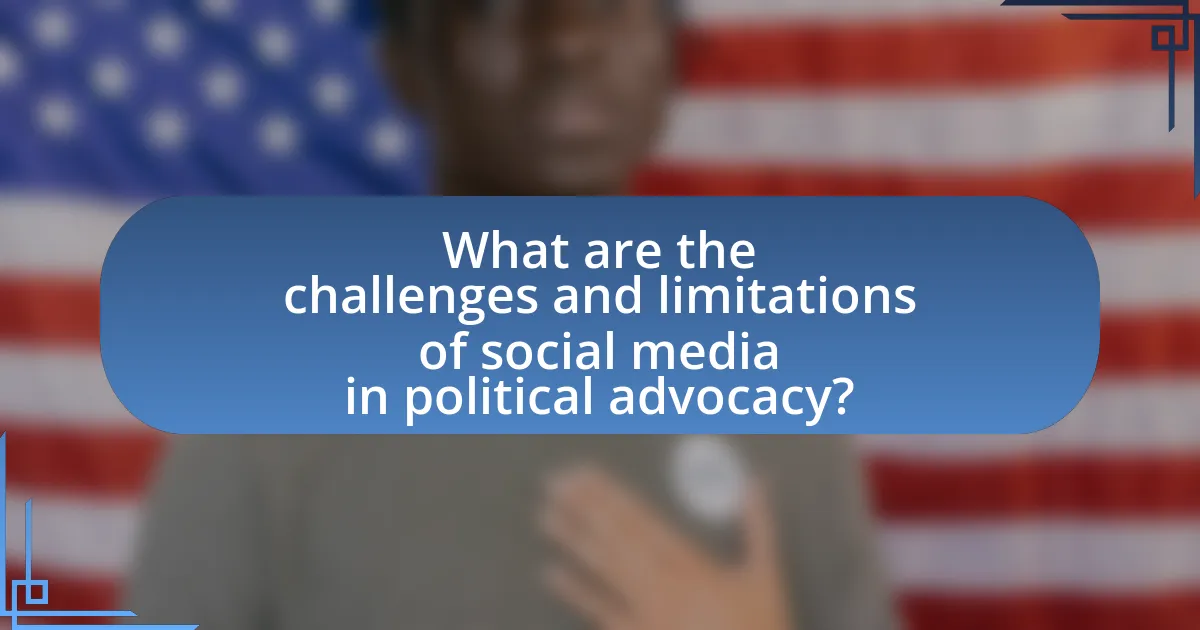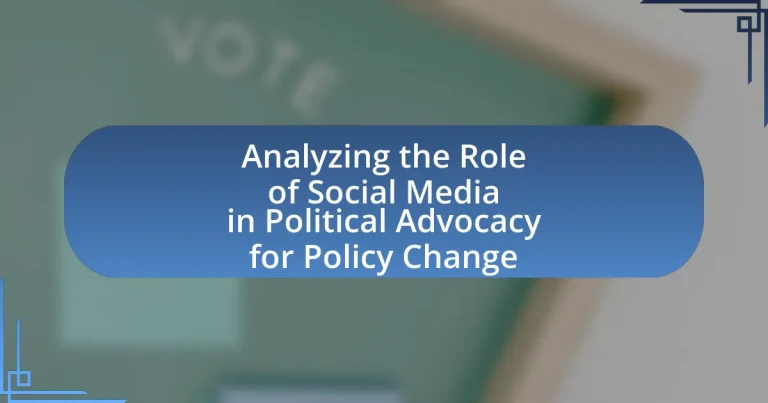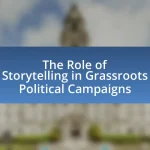The article analyzes the role of social media in political advocacy for policy change, highlighting its significance in facilitating communication, mobilizing supporters, and amplifying messages. It discusses how social media has transformed political advocacy by enabling rapid information dissemination and grassroots mobilization, exemplified by movements like the Arab Spring and #MeToo. Key features such as widespread reach, real-time communication, and user-generated content are examined, along with the effectiveness of various platforms in engaging audiences. The article also addresses the challenges of misinformation and algorithmic biases, offering strategies for advocacy groups to enhance their impact and build trust in their campaigns.

What is the Role of Social Media in Political Advocacy for Policy Change?
Social media plays a crucial role in political advocacy for policy change by facilitating communication, mobilizing supporters, and amplifying messages. It enables activists and organizations to reach a wide audience quickly, allowing for the rapid dissemination of information regarding policy issues. For instance, during the Arab Spring, social media platforms like Twitter and Facebook were instrumental in organizing protests and sharing real-time updates, which significantly influenced political outcomes in several countries. Additionally, studies have shown that social media campaigns can increase public awareness and engagement, leading to greater pressure on policymakers to respond to advocacy efforts.
How has social media transformed political advocacy?
Social media has transformed political advocacy by enabling rapid communication and mobilization of supporters. Platforms like Twitter and Facebook allow activists to disseminate information quickly, organize events, and engage with a broader audience. For instance, the Arab Spring in 2011 showcased how social media facilitated grassroots movements, leading to significant political changes in several countries. Additionally, studies indicate that social media campaigns can increase political participation; a 2018 Pew Research Center report found that 69% of Americans use social media, with many engaging in political discussions and activism online. This shift has made advocacy more accessible and has amplified marginalized voices, fundamentally changing the landscape of political engagement.
What are the key features of social media that facilitate advocacy?
The key features of social media that facilitate advocacy include widespread reach, real-time communication, and user-generated content. Widespread reach allows advocates to connect with diverse audiences globally, enhancing visibility for their causes. Real-time communication enables immediate dissemination of information, mobilizing supporters quickly during critical moments, such as protests or campaigns. User-generated content empowers individuals to share personal stories and experiences, fostering community engagement and emotional connections that drive advocacy efforts. These features collectively enhance the effectiveness of advocacy campaigns by amplifying messages and facilitating grassroots mobilization.
How do different social media platforms serve political advocacy?
Different social media platforms serve political advocacy by providing unique tools and environments that facilitate engagement, information dissemination, and mobilization. For instance, Twitter allows for real-time communication and rapid sharing of political messages, enabling movements like #BlackLivesMatter to gain traction quickly. Facebook, with its extensive user base, supports community building and event organization, which has been crucial for grassroots campaigns such as the Women’s March. Instagram, focusing on visual content, effectively engages younger audiences through impactful imagery and storytelling, as seen in campaigns promoting climate action. Each platform’s distinct features cater to various advocacy strategies, enhancing the overall effectiveness of political movements.
Why is social media important for policy change?
Social media is important for policy change because it amplifies public discourse and mobilizes collective action. Platforms like Twitter and Facebook enable individuals and organizations to share information rapidly, raising awareness about specific issues and influencing public opinion. For instance, the #MeToo movement utilized social media to highlight sexual harassment, leading to significant policy changes in various organizations and legislative bodies. Research indicates that social media campaigns can increase civic engagement, with a study by the Pew Research Center showing that 69% of adults in the U.S. use social media, making it a powerful tool for advocacy and policy influence.
What impact does social media have on public opinion?
Social media significantly shapes public opinion by facilitating the rapid dissemination of information and enabling direct engagement between individuals and organizations. Research indicates that platforms like Twitter and Facebook can amplify voices and perspectives that may otherwise be marginalized, influencing perceptions and attitudes on various issues. For instance, a study by the Pew Research Center found that 64% of Americans believe social media has a major impact on their views about political issues, highlighting its role in shaping discourse and mobilizing public sentiment.
How does social media influence policymakers and political agendas?
Social media significantly influences policymakers and political agendas by shaping public opinion and facilitating direct communication between citizens and their representatives. Platforms like Twitter and Facebook allow for rapid dissemination of information, enabling grassroots movements to gain visibility and pressure policymakers to address specific issues. For instance, the #MeToo movement leveraged social media to bring attention to sexual harassment, prompting legislative changes in various states. Additionally, studies indicate that social media engagement can correlate with increased political participation, as seen in the 2016 U.S. presidential election, where candidates utilized social media to mobilize voters and influence campaign narratives. This demonstrates that social media serves as a powerful tool for advocacy, directly impacting policy discussions and decisions.

What strategies are used in social media political advocacy?
Social media political advocacy employs strategies such as targeted messaging, grassroots mobilization, and influencer partnerships. Targeted messaging involves creating content tailored to specific demographics, enhancing engagement and resonance with audiences. Grassroots mobilization utilizes social media platforms to organize and rally supporters, facilitating events and campaigns that amplify voices and drive action. Influencer partnerships leverage the reach and credibility of social media influencers to promote political messages, thereby increasing visibility and impact. These strategies have been shown to effectively engage users, as evidenced by the significant role social media played in movements like the Arab Spring and recent electoral campaigns, where platforms were crucial in mobilizing support and disseminating information rapidly.
How do advocacy groups utilize social media effectively?
Advocacy groups utilize social media effectively by engaging their audience through targeted messaging, real-time interaction, and mobilization efforts. These groups create compelling content that resonates with their followers, often using storytelling and visuals to enhance emotional connection. For instance, the American Civil Liberties Union (ACLU) has successfully leveraged platforms like Twitter and Facebook to raise awareness about civil rights issues, resulting in increased donations and volunteer sign-ups. Additionally, advocacy groups employ analytics tools to track engagement metrics, allowing them to refine their strategies based on audience feedback and behavior. This data-driven approach ensures that their campaigns are not only impactful but also aligned with the interests of their supporters.
What types of content are most effective for engagement?
Visual content, such as images and videos, is most effective for engagement on social media. Research indicates that posts with visuals receive 94% more views than those without. Additionally, interactive content, including polls and quizzes, significantly boosts user interaction, with 70% of consumers preferring to engage with content that allows them to participate actively. Furthermore, storytelling through narratives in posts fosters emotional connections, leading to higher engagement rates, as studies show that stories are 22 times more memorable than facts alone.
How do advocacy campaigns measure success on social media?
Advocacy campaigns measure success on social media primarily through engagement metrics, reach, and conversion rates. Engagement metrics include likes, shares, comments, and retweets, which indicate how well the content resonates with the audience. Reach measures the total number of unique users who see the campaign’s content, reflecting its visibility and potential impact. Conversion rates assess the percentage of users who take a desired action, such as signing a petition or donating, demonstrating the campaign’s effectiveness in mobilizing support. For instance, a study by the Pew Research Center found that campaigns with higher engagement rates often correlate with increased public awareness and policy influence, validating the importance of these metrics in evaluating success.
What role does user-generated content play in advocacy?
User-generated content plays a crucial role in advocacy by amplifying diverse voices and fostering community engagement. This type of content, created by individuals rather than organizations, enhances authenticity and relatability, making advocacy messages more impactful. Research indicates that campaigns utilizing user-generated content can increase engagement rates by up to 50%, as seen in the #MeToo movement, where personal stories shared on social media galvanized widespread support and awareness for sexual harassment issues. By leveraging user-generated content, advocacy efforts can create a sense of belonging and collective action, driving policy change more effectively.
How can individuals contribute to advocacy through social media?
Individuals can contribute to advocacy through social media by sharing information, mobilizing support, and engaging in discussions about important issues. By posting relevant content, individuals can raise awareness and educate their followers about specific causes, which can lead to increased public interest and action. For instance, studies show that social media campaigns can significantly amplify messages, with platforms like Twitter and Facebook enabling rapid dissemination of information to large audiences. Additionally, individuals can organize online petitions or events, fostering community engagement and collective action. Research indicates that social media has been instrumental in movements such as the Arab Spring, where grassroots advocacy led to significant political change.
What are the risks and challenges of user-generated content in advocacy?
User-generated content in advocacy poses several risks and challenges, including misinformation, lack of credibility, and potential for polarization. Misinformation can spread rapidly through social media platforms, leading to the dissemination of false narratives that undermine advocacy efforts. A study by the Pew Research Center found that 64% of Americans believe that misinformation has a significant impact on public opinion, which can distort the intended message of advocacy campaigns. Additionally, user-generated content often lacks the vetting processes that traditional media undergo, resulting in a credibility gap that can weaken the overall effectiveness of advocacy initiatives. Furthermore, the nature of social media can amplify polarized views, creating echo chambers that hinder constructive dialogue and compromise, as highlighted in research by the Knight Foundation, which indicates that social media can exacerbate divisions within communities. These factors collectively challenge the integrity and impact of advocacy efforts reliant on user-generated content.

What are the challenges and limitations of social media in political advocacy?
Social media faces significant challenges and limitations in political advocacy, primarily due to misinformation, echo chambers, and algorithmic biases. Misinformation can spread rapidly on platforms, undermining the credibility of advocacy efforts; for instance, a study by the Massachusetts Institute of Technology found that false news stories are 70% more likely to be retweeted than true stories. Echo chambers limit exposure to diverse viewpoints, reinforcing existing beliefs and reducing the potential for constructive dialogue. Additionally, algorithmic biases can prioritize sensational content over factual information, skewing public perception and engagement. These factors collectively hinder the effectiveness of social media as a tool for political advocacy.
What are the potential pitfalls of relying on social media for advocacy?
Relying on social media for advocacy can lead to misinformation and superficial engagement. Misinformation spreads rapidly on social platforms, undermining the credibility of advocacy efforts; for instance, a 2020 study by the Pew Research Center found that 64% of Americans believe that social media has a mostly negative effect on the way things are going in the country, largely due to the prevalence of false information. Additionally, social media often encourages brief interactions rather than deep discussions, which can result in a lack of understanding of complex issues. This superficial engagement can dilute the effectiveness of advocacy campaigns, as users may share content without fully grasping its implications.
How can misinformation affect political advocacy efforts?
Misinformation can significantly undermine political advocacy efforts by distorting public perception and eroding trust in credible sources. When false information spreads, it can lead to misinformed opinions and decisions among the electorate, which ultimately affects the effectiveness of advocacy campaigns. For instance, a study by the Pew Research Center found that 64% of Americans believe that misinformation has a major impact on their understanding of political issues. This distortion can result in decreased engagement, as individuals may become disillusioned or confused about the advocacy goals, leading to reduced support for initiatives aimed at policy change.
What are the implications of algorithm-driven content on advocacy visibility?
Algorithm-driven content significantly impacts advocacy visibility by determining which messages reach broader audiences based on engagement metrics. This means that advocacy campaigns may gain visibility if their content aligns with algorithmic preferences, such as being shareable or engaging, while less engaging content may be suppressed. For instance, research by the Pew Research Center indicates that social media algorithms prioritize content that generates high interaction rates, which can skew visibility towards more sensational or emotionally charged advocacy messages, potentially sidelining nuanced or critical issues. Consequently, advocacy groups must adapt their strategies to create content that resonates with these algorithms to enhance their visibility and influence in the political landscape.
How can advocacy groups overcome these challenges?
Advocacy groups can overcome challenges by leveraging social media strategically to enhance their outreach and engagement. By utilizing targeted campaigns, advocacy groups can reach specific demographics effectively, as evidenced by studies showing that social media can increase engagement rates by up to 50% when tailored to audience interests. Additionally, fostering partnerships with influencers can amplify their message, as influencers often have established trust with their followers, leading to higher conversion rates for advocacy initiatives. Furthermore, continuous monitoring of social media analytics allows advocacy groups to adapt their strategies in real-time, ensuring that their messaging remains relevant and impactful.
What best practices can enhance the effectiveness of social media advocacy?
To enhance the effectiveness of social media advocacy, organizations should focus on creating clear, engaging content that resonates with their target audience. Engaging visuals, concise messaging, and storytelling can significantly increase user interaction and shareability. Research indicates that posts with images receive 94% more views than those without, highlighting the importance of visual content in capturing attention. Additionally, utilizing data analytics to track engagement metrics allows advocates to refine their strategies based on audience preferences and behaviors. Consistent posting and active engagement with followers foster community and trust, which are crucial for mobilizing support for policy change.
How can advocacy groups build trust and credibility on social media?
Advocacy groups can build trust and credibility on social media by consistently sharing accurate information and engaging transparently with their audience. Consistent sharing of verified data, such as statistics from reputable sources, demonstrates reliability; for instance, a study by the Pew Research Center found that 64% of users trust organizations that provide clear and factual information. Additionally, responding promptly to inquiries and addressing concerns fosters a sense of community and accountability, which further enhances credibility. Engaging in open dialogues and showcasing real stories from affected individuals can also humanize the advocacy efforts, making them more relatable and trustworthy to the audience.
What are the future trends in social media political advocacy?
Future trends in social media political advocacy include increased use of artificial intelligence for targeted messaging, the rise of decentralized platforms, and enhanced engagement through interactive content. Artificial intelligence enables campaigns to analyze voter behavior and tailor messages effectively, as evidenced by the use of AI in the 2020 U.S. elections, where data-driven strategies significantly influenced voter outreach. Decentralized platforms, such as blockchain-based social media, are gaining traction as they offer greater user control and privacy, appealing to users concerned about data security. Additionally, interactive content, including live streams and polls, fosters real-time engagement, as seen in recent political campaigns that utilize these formats to mobilize supporters and gather feedback instantly.
How might emerging technologies impact advocacy strategies?
Emerging technologies significantly enhance advocacy strategies by enabling more effective communication, data analysis, and mobilization of supporters. For instance, social media platforms allow advocates to reach wider audiences instantly, facilitating rapid dissemination of information and engagement with diverse demographics. According to a 2020 study by the Pew Research Center, 69% of adults in the U.S. use social media, making it a crucial tool for advocacy campaigns to influence public opinion and policy change. Additionally, data analytics tools help organizations assess the impact of their campaigns in real-time, allowing for strategic adjustments that increase effectiveness. These technologies collectively empower advocacy efforts by improving outreach, engagement, and responsiveness to public sentiment.
What role will social media play in future political movements?
Social media will serve as a crucial platform for mobilizing support and disseminating information in future political movements. It enables rapid communication, allowing activists to organize events, share messages, and engage with a broader audience instantly. For instance, the Arab Spring demonstrated how platforms like Twitter and Facebook facilitated grassroots organizing and real-time updates, leading to significant political changes in several countries. Additionally, studies indicate that social media can amplify marginalized voices, making it easier for diverse groups to participate in political discourse and advocacy. This trend is expected to continue, as more individuals rely on social media for news and community engagement, further solidifying its role in shaping political landscapes.
What practical tips can enhance social media advocacy efforts?
To enhance social media advocacy efforts, organizations should focus on creating engaging, shareable content that resonates with their target audience. Engaging content, such as infographics, videos, and personal stories, increases the likelihood of shares and interactions, which can amplify the message. Research indicates that posts with visuals receive 94% more views than those without, highlighting the importance of visual elements in advocacy campaigns. Additionally, utilizing targeted hashtags can improve visibility and connect with broader conversations, as evidenced by the success of campaigns like #MeToo, which mobilized millions globally. Regularly interacting with followers through comments and direct messages fosters community and encourages participation, further strengthening advocacy efforts.


